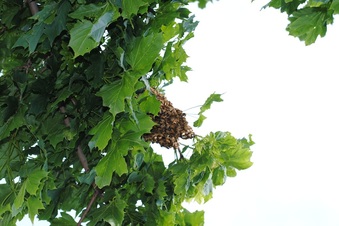
One of the rights of passage for a beekeeper is the swarm call. That's the call from a neighbor, friend, or random citizen to announce that they have a swarm on a tree (or swing, building, lamppost) inciting terror in passersby. The caller is usually looking for someone to remove the perceived threat and may have first summoned an exterminator only to learn to exterminators can only kill honeybee swarms under extreme circumstances in most states. The reality is that swarms (of non-africanized bees) are incredibly docile and a true wonder of nature.
This week we got our first swarm call and passed our initiation into the world of beekeeping. Our call came from our mentor and president of the local beekeepers club. A small swarm had set up temporary residence on a tree in the parking lot outside the main entrance of a local food processing plant. The company's pest management firm had contacted the beekeepers association to identify a local resource to remove the swarm. We turned out to be the closest club members to the location and were known to be looking to add a second colony to our apiary. After a quick call to the business facilities team we scheduled to attempt the swarm collection late afternoon / early evening if the swarm hadn't relocated by then.
Upon arrival at the site we set up a light colored sheet underneath the swarm, placed a 5 frame Nuc box on the sheet, donned our gear and got about our business. The process of removing the swarm was simple enough. We misted the swarm and the entrance to the Nuc box with a 1:1 mixture of sugar and water, climbed a step ladder, pulled down the branch containing the swarm as low as possible, and gave it a couple of quick hard shakes. Most of the bees fell onto the sheet just in front of the waiting box. Almost immediately a few of the girls entered the Nuc, came back outside and began emitting pheromone to let the confused bees reorganize in front of the box. After a few minutes the entire colony formed a chain and began walking collectively into our waiting hive box. A large group of bees toward the rear of the train continued to signal for bees flying in the air or returning to the tree to join the swarm on the ground. At this point our job was to simply wait for the bees to walk into their new home. Most of the workers at the plant were now leaving for the evening and we had many employees curious about the swarm and the collection process. We spent about an hour at the plant mostly answering questions about bees, beekeeping, and swarms from the employees.
After an hour most of the bees had settled into the Nuc. We stapled some 1/8" hardware screen over the entrance, secured the body, lid and bottom together, loaded the Nuc into the pickup truck and headed back to the farm. We placed the box in our bee yard, performed a quick scan to spot the queen, provided a few frames of existing drawn comb, and added a quart of sugar syrup via a top feeder to assist them drawing new comb on foundation. Since this was an after swarm, our queen likely still needs to make her mating flight. We'll keep the ladies fed and check back in a few weeks when she should be busy laying eggs.
It has been an exciting first month for us as beekeepers. We got into the beekeeping hobby the old fashioned way - collecting and capturing swarms. It has been an interesting journey and we wouldn't have it any other way!
This week we got our first swarm call and passed our initiation into the world of beekeeping. Our call came from our mentor and president of the local beekeepers club. A small swarm had set up temporary residence on a tree in the parking lot outside the main entrance of a local food processing plant. The company's pest management firm had contacted the beekeepers association to identify a local resource to remove the swarm. We turned out to be the closest club members to the location and were known to be looking to add a second colony to our apiary. After a quick call to the business facilities team we scheduled to attempt the swarm collection late afternoon / early evening if the swarm hadn't relocated by then.
Upon arrival at the site we set up a light colored sheet underneath the swarm, placed a 5 frame Nuc box on the sheet, donned our gear and got about our business. The process of removing the swarm was simple enough. We misted the swarm and the entrance to the Nuc box with a 1:1 mixture of sugar and water, climbed a step ladder, pulled down the branch containing the swarm as low as possible, and gave it a couple of quick hard shakes. Most of the bees fell onto the sheet just in front of the waiting box. Almost immediately a few of the girls entered the Nuc, came back outside and began emitting pheromone to let the confused bees reorganize in front of the box. After a few minutes the entire colony formed a chain and began walking collectively into our waiting hive box. A large group of bees toward the rear of the train continued to signal for bees flying in the air or returning to the tree to join the swarm on the ground. At this point our job was to simply wait for the bees to walk into their new home. Most of the workers at the plant were now leaving for the evening and we had many employees curious about the swarm and the collection process. We spent about an hour at the plant mostly answering questions about bees, beekeeping, and swarms from the employees.
After an hour most of the bees had settled into the Nuc. We stapled some 1/8" hardware screen over the entrance, secured the body, lid and bottom together, loaded the Nuc into the pickup truck and headed back to the farm. We placed the box in our bee yard, performed a quick scan to spot the queen, provided a few frames of existing drawn comb, and added a quart of sugar syrup via a top feeder to assist them drawing new comb on foundation. Since this was an after swarm, our queen likely still needs to make her mating flight. We'll keep the ladies fed and check back in a few weeks when she should be busy laying eggs.
It has been an exciting first month for us as beekeepers. We got into the beekeeping hobby the old fashioned way - collecting and capturing swarms. It has been an interesting journey and we wouldn't have it any other way!
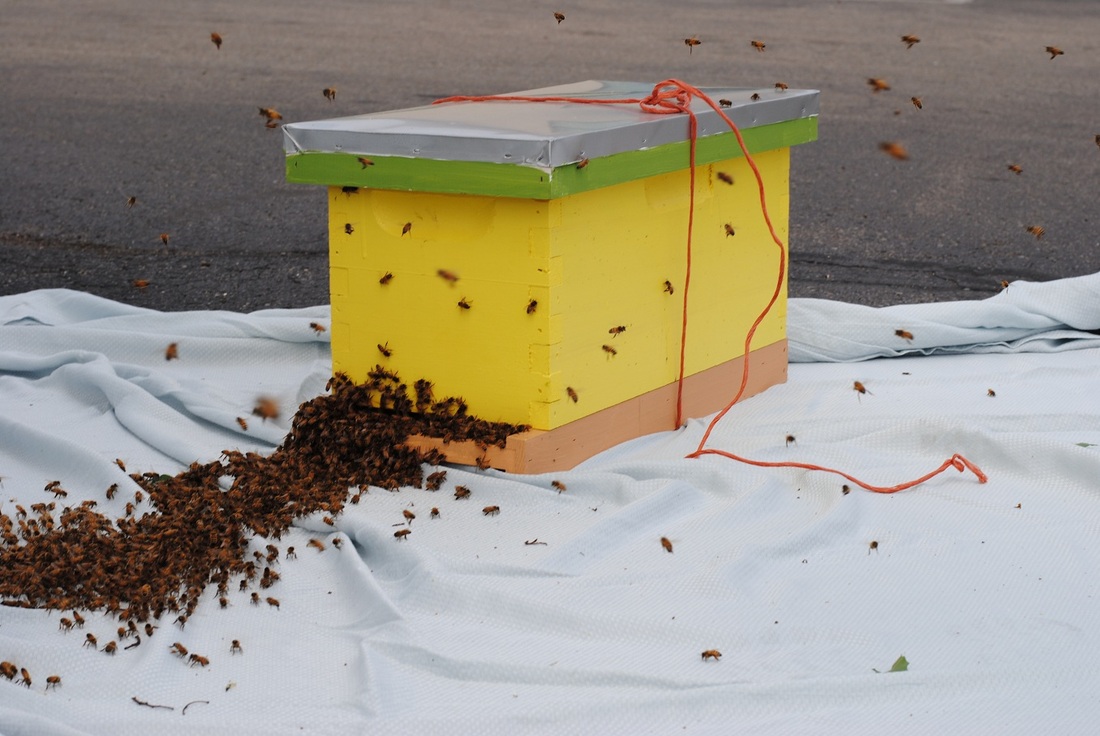
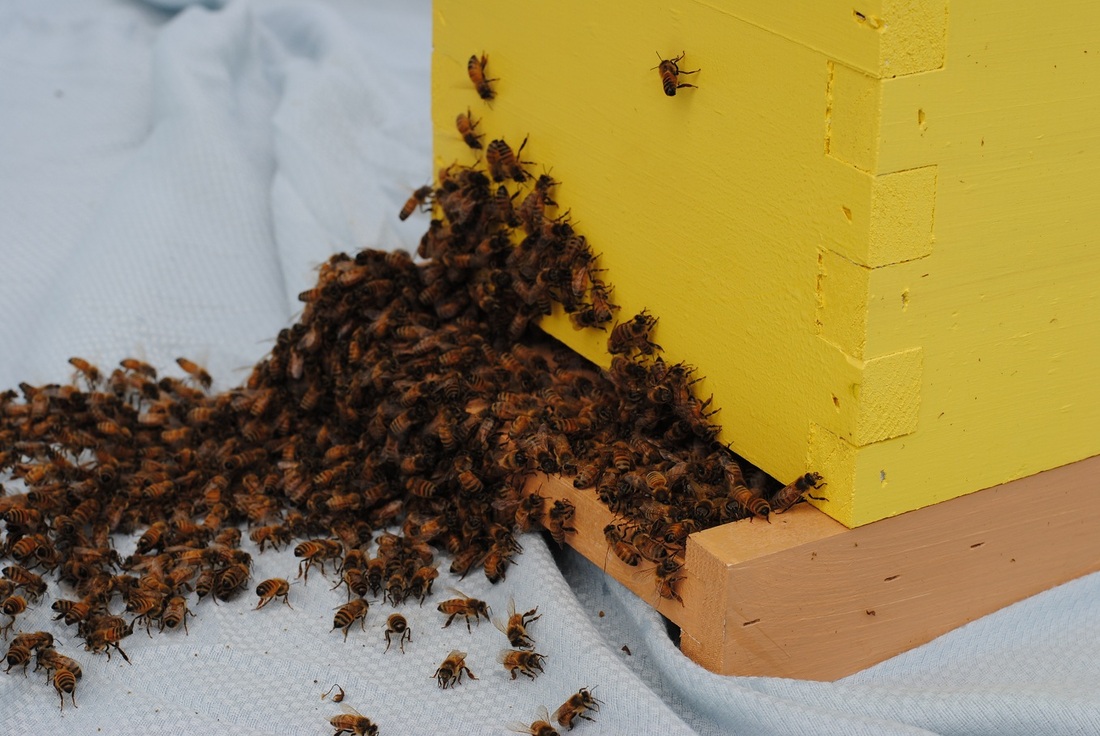

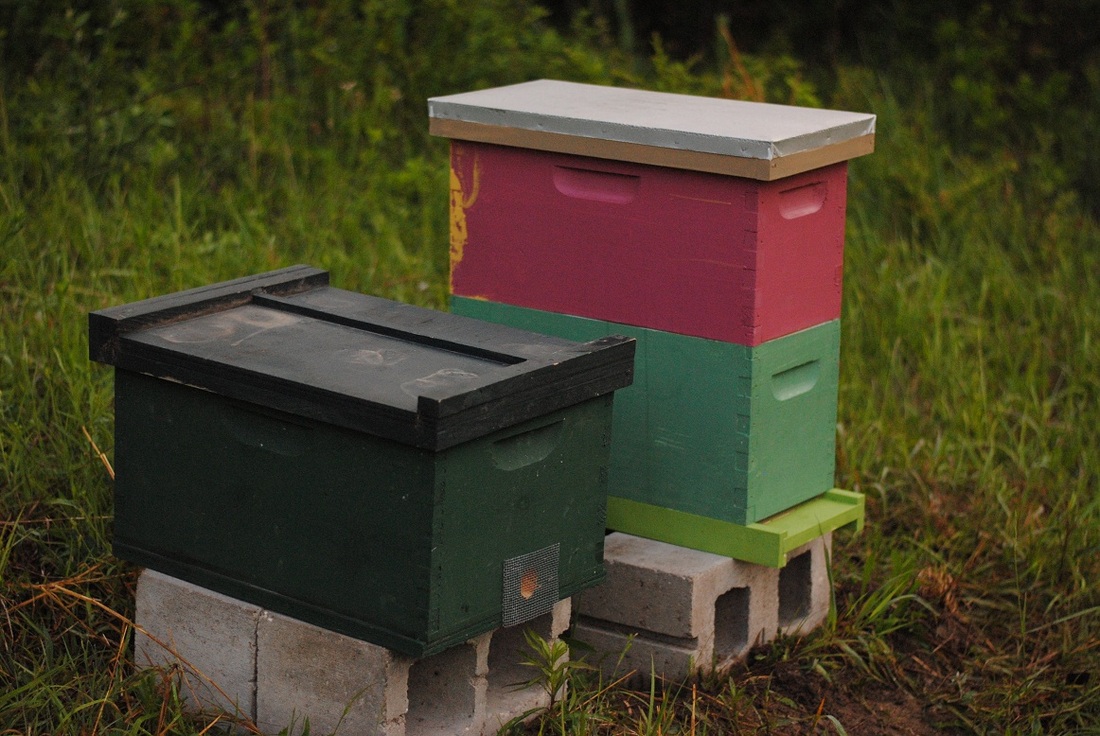
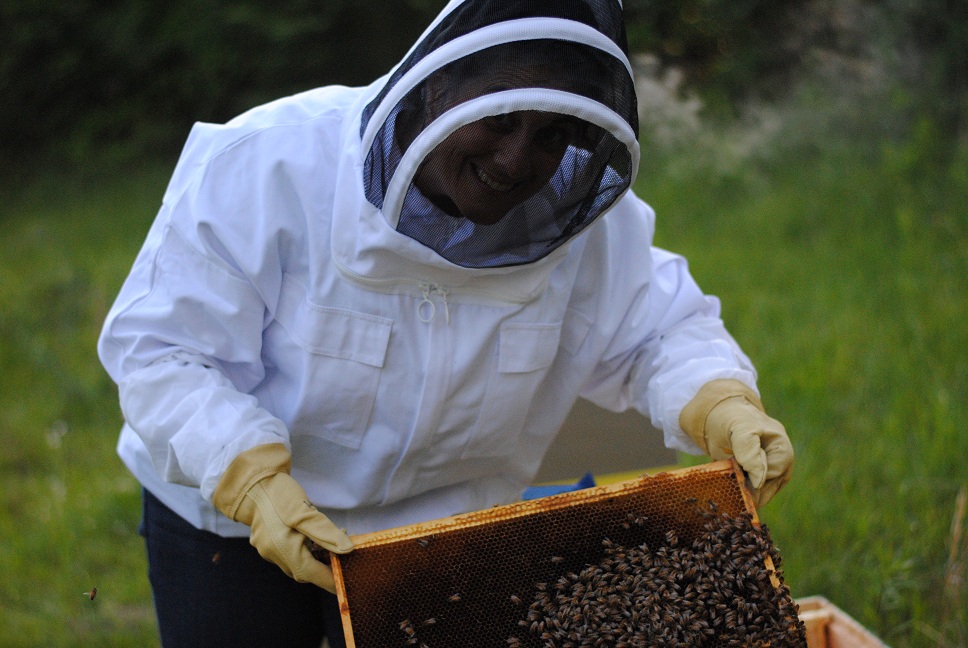
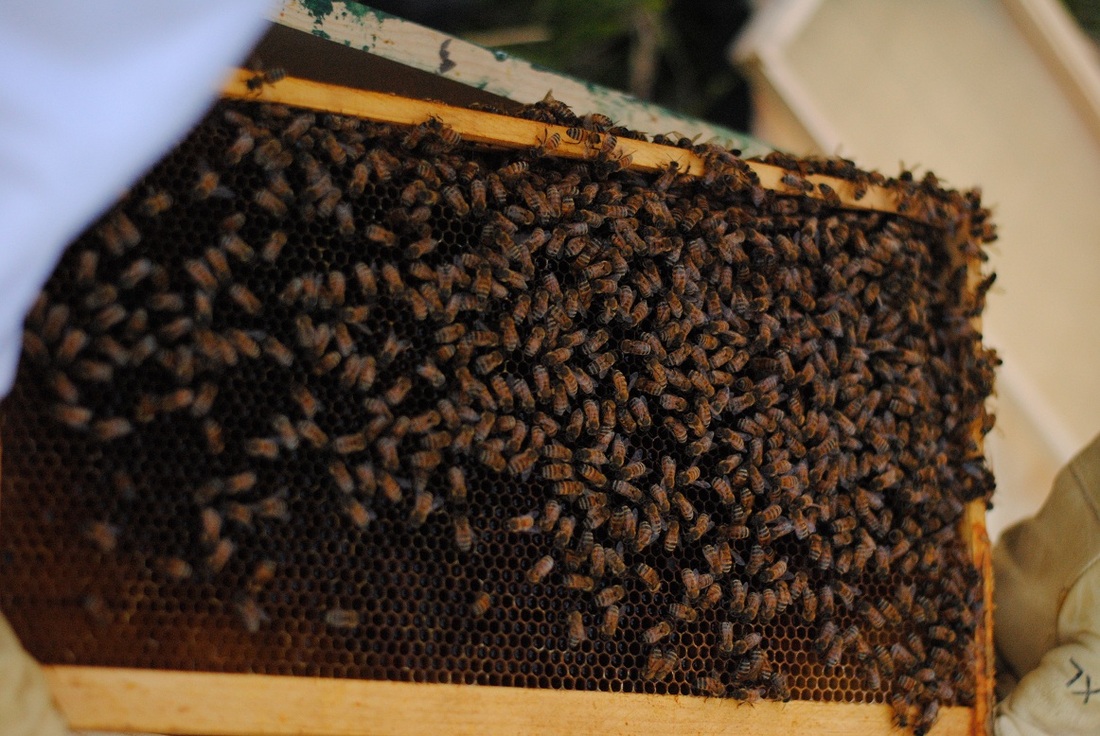
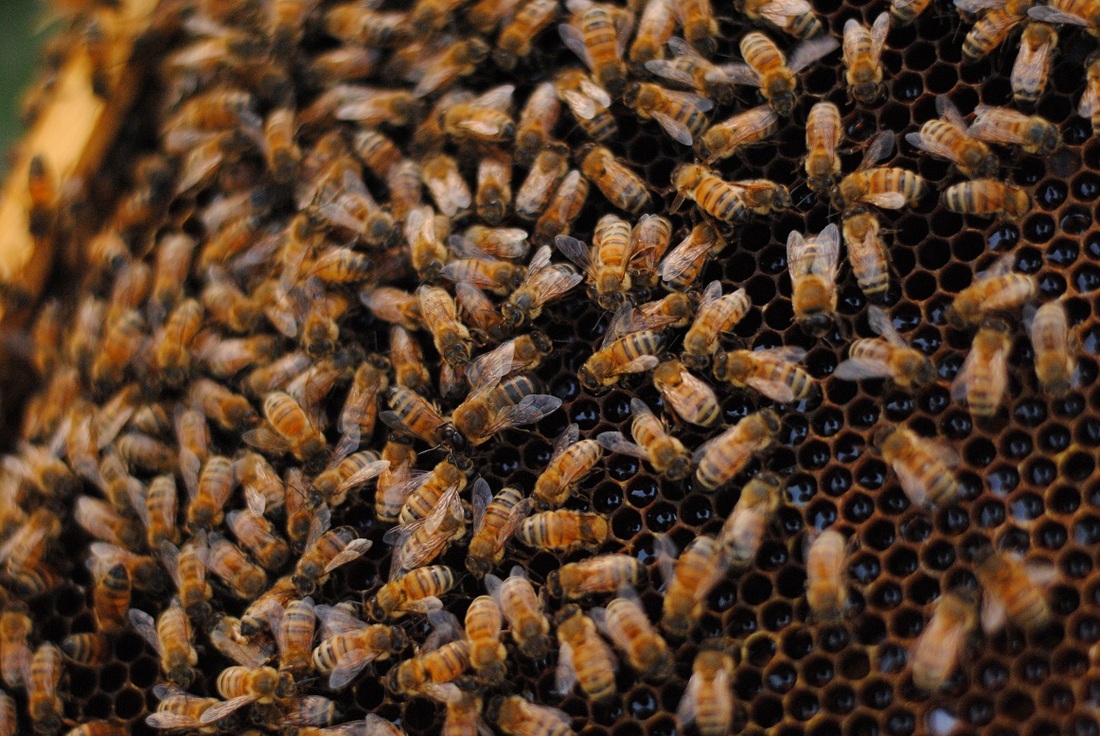
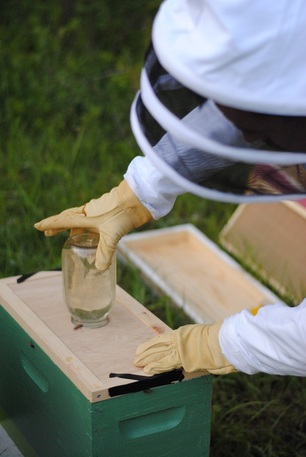

 RSS Feed
RSS Feed